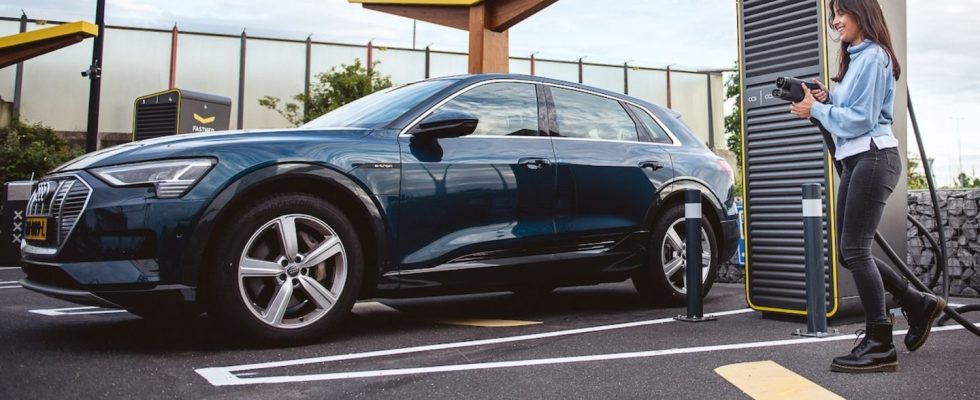Until now, electric cars that could recharge with more than 250 kilowatts were the rare exception. Models such as the Audi Etron GT and Porsche Taycan were able to recharge the battery packs in the underbody with up to 270 kW and, in addition to the current Tesla models, vehicles from Kia, Hyundai and Genesis have particularly shone in the charging parks. But more and more vehicles are slowly getting a taste for powerful 800-volt charging and the first models have even increased it to 900 volts.
Mercedes will be bringing its next generation of electric cars onto the market at the end of the year, which also features 800-volt technology, and new models such as the Audi Q6, Porsche Macan and the revised Taycan have once again improved significantly thanks to the symbiosis of new battery and charging technology. The best example is the twin pair of the new Porsche Taycan and the Audi Etron GT, which were able to increase their already opulent charging speeds from 270 to over 320 kilowatts in the new model year. The Lucid Air with its 900-volt technology is not a car that the driver would want to stop at a normal fast-charging station anyway.
There are big differences between fast charging stations and hyperchargers
Because fast charging stations are not the same as hyperchargers. Hyperchargers are those charging stations that can be used to recharge with more than 150 kilowatts. Fast chargers are sufficient for those vehicles that want to refuel up to 130 to 150 kW. But especially those who are traveling for a longer distance don’t want to spend too much time at the charging station and nameless cafés, pale burger joints or abandoned snack bars on motorways and connecting roads are not that charming.
Many of the previous HPC charging stations offer a maximum charging speed of 300 kW. The next generation of columns is noticeably improving here. Fastned opened its first charging stations with 400 kilowatts more than a year ago. However, since there is no vehicle that can charge at this speed, the new charging technology was important so that two vehicles could refuel in parallel with 200 kilowatts each.
The supposed 150 or 300 kW chargers are often a sham, as this speed only applies to an electric vehicle. If two cars are connected, the brisk 300 kilowatts only become twice as moderate 150 kW. Shortly before Christmas, Fastned opened four additional charging points with a speed of 400 kW on the A4 motorway between Aachen and Cologne.
These are becoming increasingly interesting for all vehicles that can fill well over 300 kW. This is definitely noticeable on the watch. Since models like the Porsche Taycan or the latest generation Audi Etron GT can charge for up to five minutes with more than 300 kilowatts, the charging time is halved from 10 to 80 percent from 37 to 18 minutes – despite an increased gross energy content of 105 previously 93 kWh.
A charging station in the middle of nowhere is not enough for many people
Ionity is also relying on an increased speed of 350 kW for its new charging stations. This reduces the 50 kWh charging time from 20 minutes at 150 kW to nine minutes on the 350 columns. Mercedes also wants to install similar 350 kW chargers in its own charging network. Depending on the location, the charging stations with a star should offer four to twelve high-power chargers with up to 350 kW charging power. Thanks to intelligent charging management, every connected vehicle should receive the maximum charging speed.
But it’s not just about the speed itself, because handling on site is also an issue for many electric car drivers. The word has now gotten around among the operators that a few bright LED spotlights in the dark commercial area are far from enough. Customers want security, especially in the evenings and at night, a roof against rain and snow and, ideally, a connection to local infrastructure so that waiting times in a restaurant, snack bar or shop can be shortened.
Removable batteries have so far been a marginal phenomenon
And a charging parking provider like Ionity is proud that the charging card or smartphone with the app can stay in your pocket in the future. Those vehicles that have so-called Plug & Charge technology then only have to be plugged in and, like Tesla, the charging process begins independently without the driver having to do anything. Then unplug it and continue driving. This also saves time and makes refueling more pleasant.
Nio will be taking its charging stations a step further in the future, because the Chinese don’t want to just stick with the patented technology of the removable battery at the so-called swap stations (now announced in the fourth generation). At the end of the year, not only the new top model of the Nio ET9 was presented, but also the liquid-cooled power charger, which has up to 640 kilowatts of power and once again clearly eclipses the announced 500 kW charger. These Hyperchargers are intended for both the Chinese and European markets. The whole thing is noticeably picking up speed.

